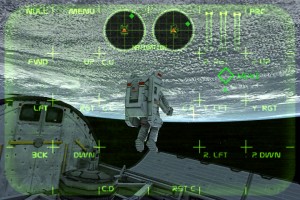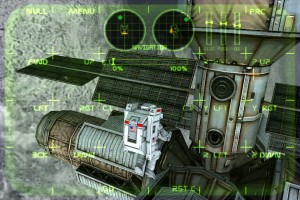Just last week we previewed Jorge Hernandez’ daring second App Store submission. Now that Astronaut: Spacewalk is out on sale for $3.99, it’s time to take a closer look at the game that’s so complex, you’ll actually leave the experience a little more suited for work in outer space.
 I’ll say it straight it out: Spacewalk is not a pick-up-and-play game in any way, shape or form. If you ignore the in-game manual and dive right in like I did, you’ll spend your first few minutes getting the poor astronaut so tangled up that you’ll have to abort the intro mission. The movement system will defeat you utterly and send you trudging for that digital instruction booklet after all, and you’ll have to put on your reading glasses for careful study. It is worth doing, however, because the game becomes incredibly rewarding once you get the hang of it.
I’ll say it straight it out: Spacewalk is not a pick-up-and-play game in any way, shape or form. If you ignore the in-game manual and dive right in like I did, you’ll spend your first few minutes getting the poor astronaut so tangled up that you’ll have to abort the intro mission. The movement system will defeat you utterly and send you trudging for that digital instruction booklet after all, and you’ll have to put on your reading glasses for careful study. It is worth doing, however, because the game becomes incredibly rewarding once you get the hang of it.
Let me explain a little about how the interface works exactly. All those crosshairs splayed over the screen block out virtual buttons. The left-hand buttons control displacement: forward, back, up, down, and left and right strafing. The right-hand buttons orient your astronaut along pitch, roll and yaw axes; again, I’d highly recommend keeping this Wikipedia diagram handy since the pitch-roll-yaw system might be easier to think about in terms of an airplane. Add a few miscellaneous functions and yes, you are looking at over a dozen virtual buttons to keep straight in your mind — probably a record for the platform!
The bedrock skill every Spacewalk player needs to master is moving along one axis at a time, canceling out the astronaut’s current momentum before making a course adjustment. A “Null” button does the canceling for you automatically but the electricity reserve it draws from is quickly spent — there’s no relying on it as a crutch, its purpose being to get you out of a jam when you lose your nerve. It helps that the player has a few advantages a NASA astronaut typically doesn’t, like silhouette orientation guides and radars that help you find your mission goals even when you don’t have a clear view of them at first.
 Spacewalk isn’t about scoring points or adding minor achievements to your Game Center record. The goal here is to score the most meaningful achievement of them all: perfect performance. When you’re floating around in space, a course correction of a few degrees can spell the difference between success and failure, especially when your oxygen and fuel supplies are tightly budgeted for each mission. Getting in position for repairs and settling into docking stations are long, stressful procedures that’ll have you breaking a sweat as you go through the necessary mental gymnastics.
Spacewalk isn’t about scoring points or adding minor achievements to your Game Center record. The goal here is to score the most meaningful achievement of them all: perfect performance. When you’re floating around in space, a course correction of a few degrees can spell the difference between success and failure, especially when your oxygen and fuel supplies are tightly budgeted for each mission. Getting in position for repairs and settling into docking stations are long, stressful procedures that’ll have you breaking a sweat as you go through the necessary mental gymnastics.
Master the little details of moving about in space and you’ll come away with the feeling that you’re one of the few, the proud; that sense of accomplishment glues the whole experience together and keeps you coming back if only you can stick out the awkward learning phase. Aside from lack of a live tutorial, Spacewalk suffers a bit from noticeable load times while firing up missions.
Spacewalk may have fewer objects to juggle than most 3D games but they’re all beautifully rendered — Earth especially. Too bad they aren’t more animated though; the astronaut remains still while conducting repair work, for example. Clips of NASA chatter are put to exquisite use on the audio side, typically meshing so well with your astronaut’s current status and mission objectives you won’t believe your earbuds!
iFanzine Verdict: There’s no doubting that Astronaut: Spacewalk is one of the most difficult iOS games to get into, but once you survive the learning phase, you might be surprised at how hooked you are. If you’re a space enthusiast or just looking for a rewarding challenge and don’t mind complexity, grab it while it’s on sale.


